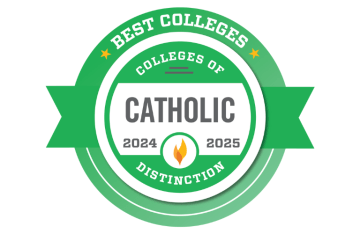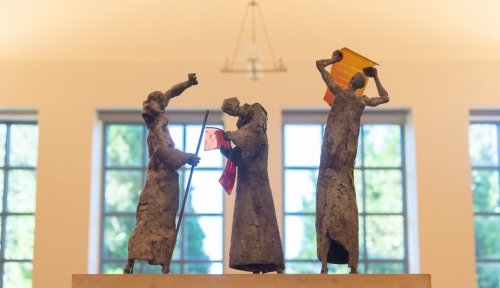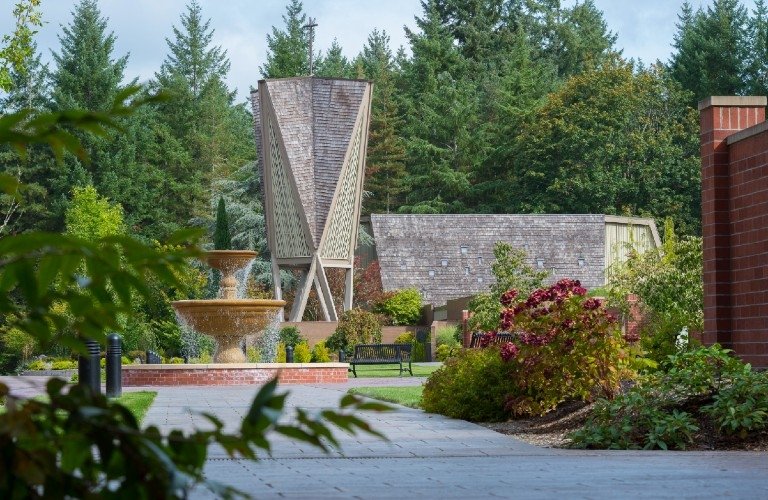Peace [Pax] is indeed one of the principal mottos of the Benedictine order. It is primary in the Benedictine lexicon of spirituality. It is by no means an overstatement to say that as a motto, Pax is the Benedictine Way. When one visit various Benedictine monasteries, one frequently sees this simple Latin word, ‘Pax’, or its slightly longer formulation, ‘Pax intrantibus’ – ‘peace to those entering here’ - above a main doorway or entrance.
At our beautiful university grounds here at Saint Martin’s, it is virtually impossible not to encounter the very peace of this place. This is deeply intentional, and not accidental. Without it, our university and its liberal arts education would simply not be able to function.
Such peace is both invisible, yet unmistakably present wherever you look. And yet peace cannot be ‘bottled up’, nor bought and sold in a utilitarian manner. It is notoriously difficult to positively identify and point towards – There it is! This is Peace. And yet, despite such difficulty in directly identifying it, we nevertheless know of it in a very intimate and personal way, encapsulated by the famous Pauline phrase: the ‘peace of God which surpasses all understanding’ (Phil 4, 7). With this difficulty in mind, this is one reason why we celebrate the lives of the Saints and especially Sts. Martin and Benedict in particular. Because it is in their lives that are so uniquely, yet decisively rooted in Christ that we can indeed point towards them with unflinching confidence and say, ‘Yes. This person here, this is a man of peace!’
More often than not, however, we come to know and value such peace by way of contrasts, its absence when it is taken from us. When in certain contexts and situations, or often within ourselves, we are deprived of that very peace and are instead filled with restlessness, conflict, anxiety, aggression, violence, disorder and chaos.
We at this University immediately enjoy the fruits of the Abbey as it is part and parcel of the Benedictine vocation to continuously ‘seek out peace and pursue it’, as Benedict states famously in the Prologue to the Rule:
It is to find workers in his cause that God calls out like that to all peoples. He calls to us in another way in the psalm when he says, Who is there with a love of true life and a longing for days of real fulfillment? If you should hear that call and answer, ‘I’, this is the answer you will receive from God: If you wish to have that true life that lasts forever, then keep your tongue from evil; let your lips speak no deceit; turn away from wrongdoing; seek out peace and pursue it. (Prologue, n. 14-17)
Without peace, as the experience of the Benedictine way attests for over fifteen hundred years, our prayer and dedication towards God can seldom get off the ground, nor is there much patience and endurance to give of oneself charitably and hospitably towards others in need. Without peace, there is neither ‘ora’ [prayer], ‘labora’ [work] nor ‘lege’ [study], other equally foundational terms within the Benedictine spiritual lexicon. Peace, is thus both externally manifested in order and stability, as well as internally rooted in a life directed towards God and others. With St. Benedict as an icon of peace, let us say something now of the externals and Benedict’s ongoing example today.
Externally, peace occurs among people when we actively recognize each other’s common human dignity, our created equality in the image and likeness of God, as Christ teaches on the Sermon on the Mount: “Blessed are the peacemakers, for they will be called children of God.” (Mt 5,9) Externally, peace emerges when our common human dignity is rightfully preserved and justly promoted within our various communities and societies that are ordered towards such inviolable origins.
In the bleak days shortly after the end of WWII, as Europe began the long process of rebuilding from the rubble and horrors of utopian ideologies, of man ‘succumbing to the ancient temptation of seeking to redeem himself by himself’, the cultural legacy of Benedict and the Benedictine way of peace was frequently invoked as the Benedictines had none other than rebuilt a civilization and culture of Christian humanism after the downfall of the Roman empire and the chaos, disease and moral decline that had ensued. Then again in October of 1964, Paul VI declared St. Benedict as the ‘Patron of Europe’ in recognition of the incredible work that he had achieved in and through his Rule in the formation of this Western civilization and culture, a peace rooted in both external order and institutions, as well as anchored in its ethical and spiritual foundations. So too today, the Benedictine way of peace shines like a bright star in the dark night, as the ‘great monk is still a true master at whose school we can learn to become proficient in true humanism.’ (Benedict XVI, April 9, 2008)
“Seek out peace and pursue it”
Rule of St. Benedict, Prologue, 17.






